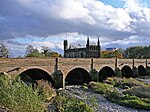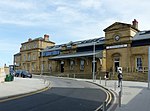Walton is a village and civil parish in the City of Wakefield in the county of West Yorkshire, England, 4 miles south-east of Wakefield. At the time of the 2011 Census, the parish had a population of 3,231. At the time of the 2011 Census the parish was part of the City of Wakefield's ward of Crofton, Ryhill and Walton. The population of this ward at the Census was 15,144.Historically part of the West Riding of Yorkshire, the village lies on the Barnsley Canal and is home to Walton Hall, once the residence of Charles Waterton, known as 'Squire' Waterton. He was a naturalist and explorer who, in 1820, transformed the grounds of the Walton Hall estate the world's first nature reserve. The estate is also often referred to on Ordnance Survey maps, etc., as Walton Park and, less frequently, as Walton Hall Park. More recently, it has become widely known as Waterton Park.
Walton Hall is now Waterton Park Hotel. The park is now largely given over to a golf course, also named Waterton Park. There are public rights of way crossing the park.
Nearby, the site of the now demolished Walton Colliery, formerly known as Sharlston West colliery, has been transformed into a nature park (Walton Colliery Nature Park). Large lakes were constructed when the reserve was landscaped in the mid-1990s and the excavated earth was then used to cover the colliery's vast spoil heaps. The village also contains a small park, a tennis club, football and rugby pitches, a newly renovated pub and a sports and social club.












